-
 Bitcoin
Bitcoin $108,960.1513
0.84% -
 Ethereum
Ethereum $2,578.1548
2.56% -
 Tether USDt
Tether USDt $1.0001
-0.02% -
 XRP
XRP $2.2702
1.71% -
 BNB
BNB $662.6676
1.28% -
 Solana
Solana $152.6556
3.53% -
 USDC
USDC $0.9999
0.00% -
 TRON
TRON $0.2865
0.80% -
 Dogecoin
Dogecoin $0.1726
5.60% -
 Cardano
Cardano $0.5883
2.60% -
 Hyperliquid
Hyperliquid $39.9405
3.10% -
 Sui
Sui $2.9147
1.24% -
 Bitcoin Cash
Bitcoin Cash $493.8494
2.04% -
 Chainlink
Chainlink $13.6129
3.68% -
 UNUS SED LEO
UNUS SED LEO $9.0589
0.46% -
 Avalanche
Avalanche $18.2965
2.82% -
 Stellar
Stellar $0.2493
4.35% -
 Shiba Inu
Shiba Inu $0.0...01178
2.25% -
 Toncoin
Toncoin $2.8078
-6.81% -
 Hedera
Hedera $0.1604
4.96% -
 Litecoin
Litecoin $87.8270
1.20% -
 Monero
Monero $320.4173
1.87% -
 Polkadot
Polkadot $3.4079
1.81% -
 Dai
Dai $1.0000
0.00% -
 Ethena USDe
Ethena USDe $1.0000
-0.01% -
 Bitget Token
Bitget Token $4.4122
0.50% -
 Uniswap
Uniswap $7.3890
1.84% -
 Aave
Aave $286.0205
5.66% -
 Pepe
Pepe $0.0...01012
4.35% -
 Pi
Pi $0.4643
3.14%
What is the largest Bitcoin mining pool by hashrate?
Foundry USA currently leads as the largest Bitcoin mining pool, leveraging strong institutional backing and strategic partnerships to dominate global hashrate distribution.
Jul 07, 2025 at 10:07 am
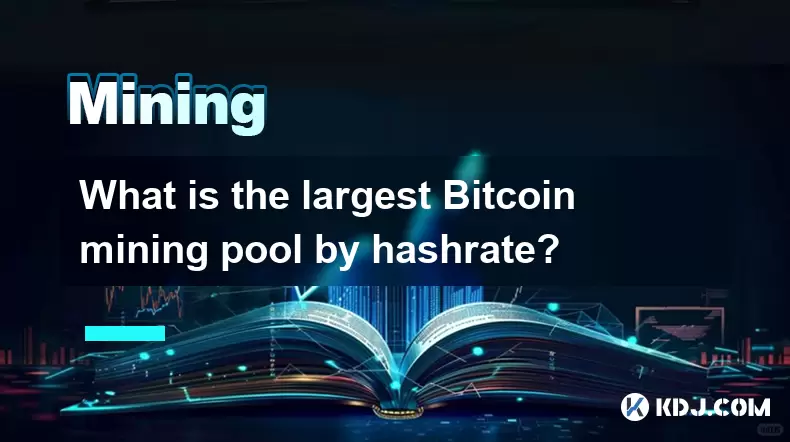
Understanding Bitcoin Mining Pools
Bitcoin mining pools are collaborative groups of miners who combine their computational resources to increase the probability of successfully mining a block. When one miner in the pool finds a valid block, the reward is distributed among all participants based on their contributed hashrate. This system allows individual miners with smaller setups to earn more consistent returns compared to solo mining.
The concept of hashrate plays a crucial role in determining the strength and efficiency of a mining pool. Hashrate refers to the total computing power used to mine and process transactions on the Bitcoin blockchain. A higher hashrate increases the likelihood of solving the cryptographic puzzle required to validate a new block, thereby increasing the potential rewards for the pool.
What Is a Mining Pool’s Share of Network Hashrate?
Each mining pool contributes a certain percentage of the total Bitcoin network hashrate. This share determines how often the pool can expect to find blocks over time. For instance, if a pool controls 20% of the network hashrate, it should theoretically find 20% of the blocks mined during a given period.
Mining pools publish real-time statistics that show their current share of the global hashrate. These figures fluctuate due to factors like miner migration between pools, hardware upgrades, and changes in electricity costs or geopolitical conditions affecting mining operations. Therefore, identifying the largest mining pool requires checking up-to-date data sources that track this metric continuously.
Identifying the Current Largest Bitcoin Mining Pool
As of recent data from multiple tracking platforms such as BTC.com and Blockchain.com, Foundry USA has emerged as the largest Bitcoin mining pool by hashrate. Foundry USA consistently holds a significant portion of the global Bitcoin hashrate, often surpassing other major players like AntPool and F2Pool.
Foundry USA’s dominance is attributed to its strong backing by Digital Currency Group (DCG) and its strategic partnerships with large-scale mining farms across North America. The company focuses on promoting transparency and regulatory compliance, which appeals to institutional investors and professional miners alike.
It's important to note that the rankings of mining pools can change rapidly depending on market dynamics. Miners frequently switch pools based on payout structures, fees, server locations, and even political considerations such as decentralization concerns.
How to Check Real-Time Mining Pool Rankings
To determine the current largest Bitcoin mining pool, users can refer to several online platforms that provide live updates on mining pool performance:
- Visit BTC.com Pool Stats to view real-time hashrate distribution.
- Explore CoinShares Pool Tracker for detailed analytics.
- Use Blockchair Mining Stats for historical comparisons.
These platforms offer charts and tables that break down each pool’s contribution to the network hashrate over different time intervals—daily, weekly, monthly, or even yearly. Some tools allow filtering by region or mining difficulty trends.
Users should ensure they’re viewing the most recent 24-hour or 7-day average, as older data may not reflect current conditions accurately. It's also useful to cross-reference multiple sites to confirm consistency in reported figures.
Factors Influencing Mining Pool Popularity
Several key factors influence why certain mining pools dominate the Bitcoin network:
- Payout Structure: Pools use various reward systems such as Pay-per-Share (PPS), Proportional, and Score-based models. Each model affects miner earnings differently.
- Fees: Most pools charge a small percentage of the mining rewards as service fees. Lower fees can attract more miners.
- Server Locations: Geographic proximity to mining rigs reduces latency and improves efficiency.
- Uptime Reliability: A stable and secure infrastructure ensures continuous mining without interruptions.
- Transparency: Open communication about pool operations and revenue distribution builds trust.
Foundry USA’s success stems from offering competitive fee structures, reliable uptime, and transparent reporting. Additionally, its support for Bitcoin Core development and advocacy for U.S.-based mining aligns with broader industry trends favoring decentralized and geographically diverse mining ecosystems.
Steps to Join a Bitcoin Mining Pool
Joining a mining pool involves several steps that must be followed carefully to ensure smooth operation:
- Choose a reputable mining pool with high hashrate participation.
- Create an account on the pool’s official website.
- Configure your mining software with the correct stratum URL, port number, worker name, and password.
- Ensure your mining rig is connected to a stable internet source.
- Start the mining software and monitor your dashboard for accepted shares and estimated earnings.
Configuring the mining software correctly is critical, as incorrect settings can lead to rejected shares or connection failures. Users should consult the pool’s documentation or support forums for specific configuration instructions tailored to their hardware setup.
Some pools provide step-by-step guides for popular mining applications like CGMiner, BFGMiner, and Awesome Miner. Following these tutorials ensures optimal performance and minimizes troubleshooting efforts later.
Frequently Asked Questions
1. What happens if a mining pool controls more than 50% of the hashrate?
If any single entity controls over 50% of the Bitcoin network hashrate, it could potentially launch a 51% attack, allowing it to double-spend coins or prevent transaction confirmations. However, such centralization risks are generally mitigated by the community’s response and miner behavior.
2. Are there any risks associated with joining large mining pools?
While larger pools offer more consistent payouts, they also contribute to centralization concerns. Some miners prefer smaller pools to support network decentralization, even if it means less predictable income.
3. Can I switch mining pools without losing my mined rewards?
Yes, miners can switch pools at any time. Any valid shares submitted before switching will still count toward the current block reward cycle, and payments will be issued according to the original pool’s schedule.
4. Do all mining pools support every type of ASIC miner?
Most pools support standard ASIC devices, but compatibility depends on the mining software and protocol used. Always check the pool’s documentation for supported hardware before joining.
Disclaimer:info@kdj.com
The information provided is not trading advice. kdj.com does not assume any responsibility for any investments made based on the information provided in this article. Cryptocurrencies are highly volatile and it is highly recommended that you invest with caution after thorough research!
If you believe that the content used on this website infringes your copyright, please contact us immediately (info@kdj.com) and we will delete it promptly.
- Babylon, Bitcoin, and the EVM Mainnet: A New Era for BTCFi?
- 2025-07-07 16:30:11
- Queen Elizabeth Coin Sells for £31,000: A Royal Fortune in Your Pocket?
- 2025-07-07 16:30:11
- Altcoin Season on the Horizon? Michael van de Poppe Eyes a Potential 76% Surge
- 2025-07-07 16:35:12
- Pi Network Price Prediction: Is $1,000 Realistic?
- 2025-07-07 14:30:13
- Cryptocurrency Fraud: Secret Service Issues Warning Amidst Rising Scams
- 2025-07-07 14:30:13
- XRP Price & Bitcoin to $3.4M by 2030? A NYC Perspective
- 2025-07-07 14:50:12
Related knowledge
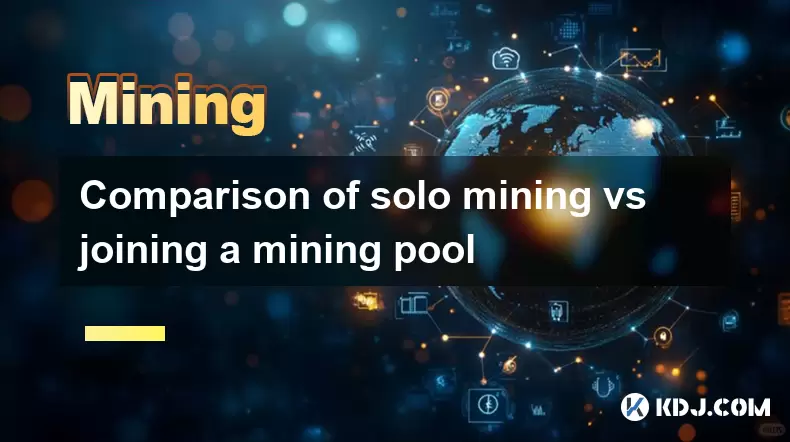
Comparison of solo mining vs joining a mining pool
Jul 05,2025 at 07:17pm
Understanding the Basics of Cryptocurrency MiningCryptocurrency mining involves validating transactions and adding them to a blockchain through computational power. Miners use specialized hardware, such as ASICs or GPUs, to solve complex cryptographic puzzles. Upon successfully solving these puzzles, miners are rewarded with newly minted coins. This pro...
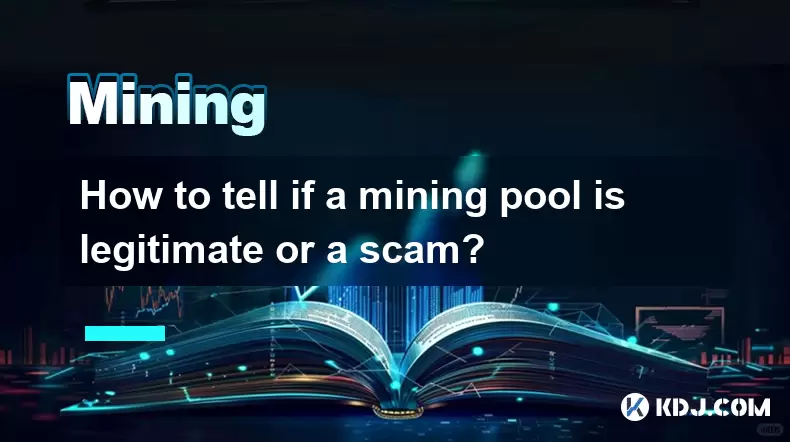
How to tell if a mining pool is legitimate or a scam?
Jul 03,2025 at 12:35pm
Understanding the Role of Mining PoolsMining pools play a crucial role in cryptocurrency mining by allowing individual miners to combine their computational resources and increase the likelihood of earning block rewards. A legitimate mining pool distributes rewards fairly, maintains transparency in operations, and has a strong community presence. Howeve...

What software do I need to join a mining pool?
Jul 05,2025 at 07:32pm
Understanding Mining Pools and Their RequirementsJoining a mining pool is an essential step for many cryptocurrency miners who want to increase their chances of earning block rewards. Unlike solo mining, where you attempt to mine blocks alone, a mining pool allows multiple miners to combine their computational resources to solve blocks more consistently...
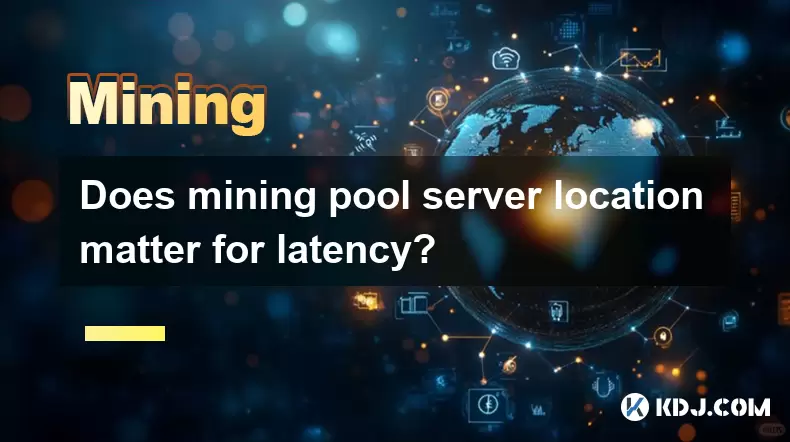
Does mining pool server location matter for latency?
Jul 06,2025 at 04:49pm
Understanding the Relationship Between Mining Pool Server Location and LatencyMining pool server location plays a crucial role in determining the latency experienced by miners during the mining process. In the context of cryptocurrency mining, latency refers to the time it takes for data packets to travel between the miner's machine and the mining pool ...

How to create your own private mining pool?
Jul 07,2025 at 02:51am
What Is a Private Mining Pool?A private mining pool is a restricted group of cryptocurrency miners who combine their computational resources to increase the probability of successfully mining a block. Unlike public pools, private mining pools are exclusive and usually require authorization or invitation to join. This exclusivity allows for better contro...
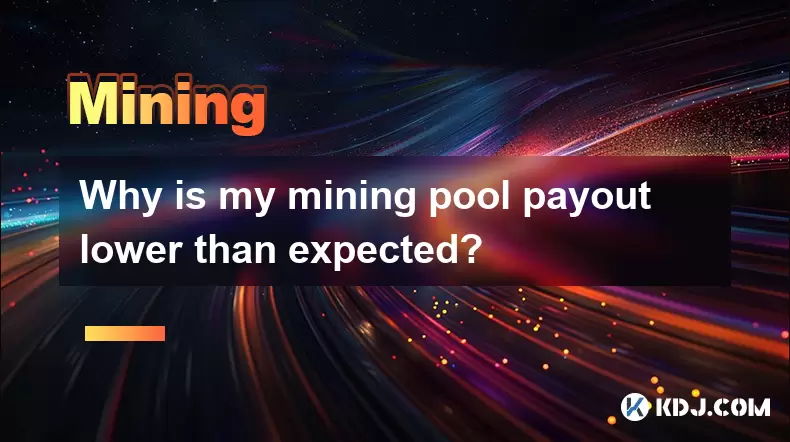
Why is my mining pool payout lower than expected?
Jul 03,2025 at 02:21am
Understanding Mining Pool Payout StructuresWhen you join a mining pool, it's important to understand the specific payout structure that the pool uses. Different pools operate under different reward systems, such as Pay Per Share (PPS), Proportional, Score-based, or Pay Per Last N Shares (PPLNS). Each method affects how and when miners receive their rewa...

Comparison of solo mining vs joining a mining pool
Jul 05,2025 at 07:17pm
Understanding the Basics of Cryptocurrency MiningCryptocurrency mining involves validating transactions and adding them to a blockchain through computational power. Miners use specialized hardware, such as ASICs or GPUs, to solve complex cryptographic puzzles. Upon successfully solving these puzzles, miners are rewarded with newly minted coins. This pro...

How to tell if a mining pool is legitimate or a scam?
Jul 03,2025 at 12:35pm
Understanding the Role of Mining PoolsMining pools play a crucial role in cryptocurrency mining by allowing individual miners to combine their computational resources and increase the likelihood of earning block rewards. A legitimate mining pool distributes rewards fairly, maintains transparency in operations, and has a strong community presence. Howeve...

What software do I need to join a mining pool?
Jul 05,2025 at 07:32pm
Understanding Mining Pools and Their RequirementsJoining a mining pool is an essential step for many cryptocurrency miners who want to increase their chances of earning block rewards. Unlike solo mining, where you attempt to mine blocks alone, a mining pool allows multiple miners to combine their computational resources to solve blocks more consistently...

Does mining pool server location matter for latency?
Jul 06,2025 at 04:49pm
Understanding the Relationship Between Mining Pool Server Location and LatencyMining pool server location plays a crucial role in determining the latency experienced by miners during the mining process. In the context of cryptocurrency mining, latency refers to the time it takes for data packets to travel between the miner's machine and the mining pool ...

How to create your own private mining pool?
Jul 07,2025 at 02:51am
What Is a Private Mining Pool?A private mining pool is a restricted group of cryptocurrency miners who combine their computational resources to increase the probability of successfully mining a block. Unlike public pools, private mining pools are exclusive and usually require authorization or invitation to join. This exclusivity allows for better contro...

Why is my mining pool payout lower than expected?
Jul 03,2025 at 02:21am
Understanding Mining Pool Payout StructuresWhen you join a mining pool, it's important to understand the specific payout structure that the pool uses. Different pools operate under different reward systems, such as Pay Per Share (PPS), Proportional, Score-based, or Pay Per Last N Shares (PPLNS). Each method affects how and when miners receive their rewa...
See all articles

























































































